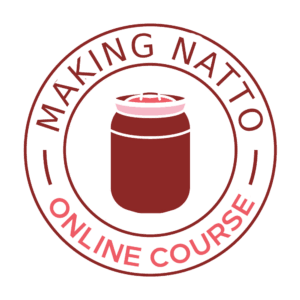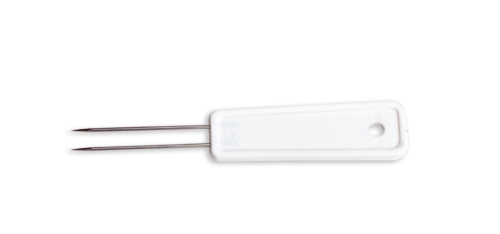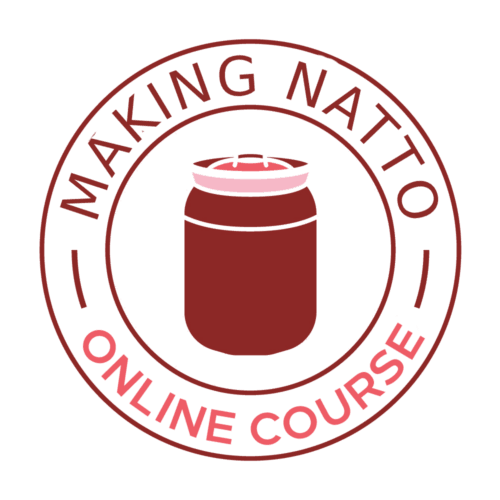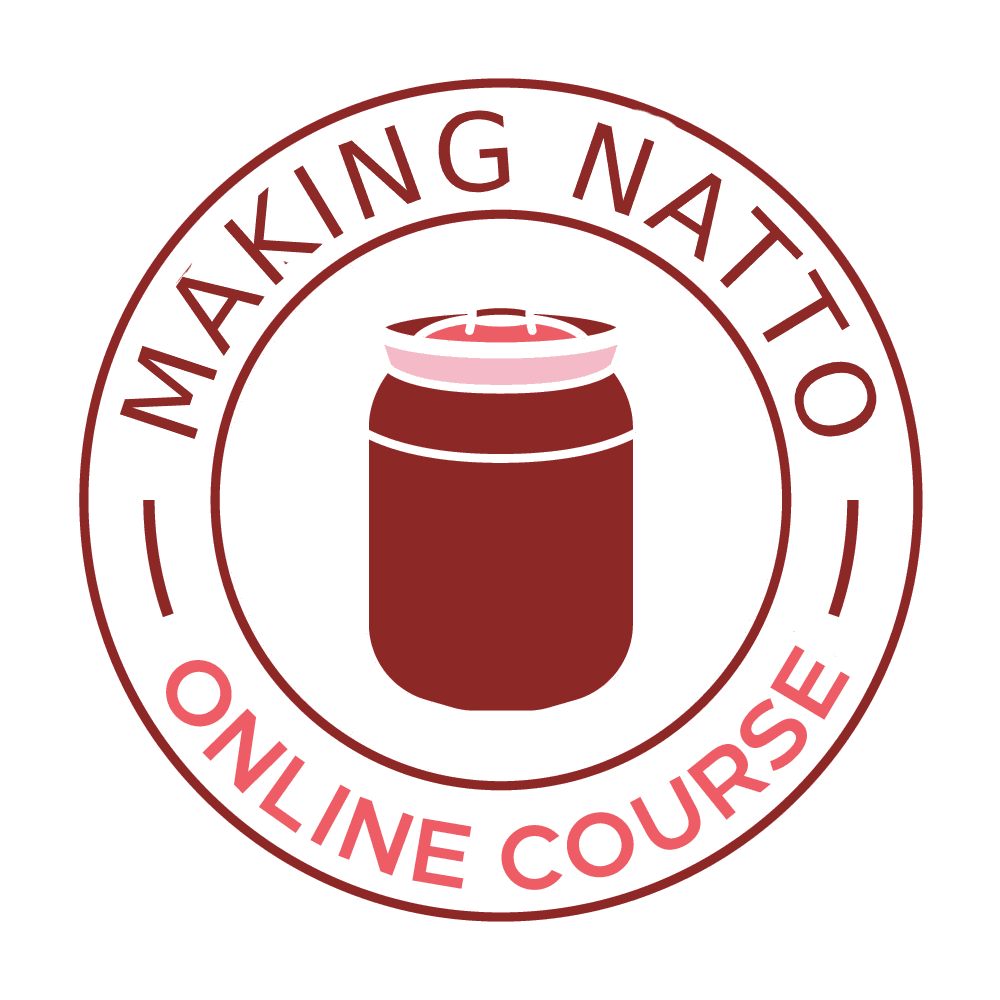Natto starter culture | make your own nattō (including recipe)
Nattō is a Japanese food made of fermented soybeans. For the preparation we use the bacterium Bacillus subtilis var. natto. Natto can also be made with beans or grains other than soybeans, such as barley.
Product Description
Make your own Nattõ with this natto starter!
What is nattō
Nattō (or simply natto) is a Japanese food made of fermented soybeans. For the preparation we use the bacterium Bacillus subtilis var. natto. The change from soya beans to natto goes via alkaline fermentation, whereby proteins (not carbohydrates) are converted into amino acids, peptides, and ammonia. This form of fermentation increases the pH. This makes the food not acidic, but alkaline.
What does natto taste like?
Traditional natto has a pungent, savory umami flavor with nutty, earthy notes that resembles aged cheese. Its mouthfeel in particular is distinct. Natto beans have a slippery texture, with a soft, but still slightly crunchy interior. It’s generally considered an ‘acquired taste’. Much like similary strong tasting products like blue cheese, it takes some time to get used to, but then you’ll be hooked forever! Natto can also be made from other beans than soy beans such as mung beans or chick peas or even grains which allows for a wide variety in natto flavors.
How do you eat natto?
Usually, natto is not consumed on it’s own, but combined. A classic combination is with rice, soy sauce and spring onion. But, natto can be added to soups, or eaten with eggs or vegetables. It’s a versatile food product, adding umami and proteins to many dishes.
Is natto healthy?
Natto is very healthy. Natto contains no cholesterol and is an important source of iron, calcium, magnesium, protein, potassium, vitamin B6, B2, E and other nutrients. It is important source of vitamin k2 which is known for its potential role in bone health and cardiovascular health. The fermentation process in natto production not only increases the total vitamin K content drastically but also converts it into the more bioavailable form of vitamin K2, making natto the no. 1 natural source of vitamine K. One tablespoon provides twice no less than twice the recommended daily intake. Also ut contains lots of easily accessable proteins, in fact more than egg by weight!
Other names for natto
Outside Japan variants of natto are made in Thailand (thua nao), China (dau chi), Nepal and Burma (kinema), and Korea (chungkuk-jang).
Natto can also be made with beans or grains other than soybeans, such as barley.
Buy our natto starter
- Available in two sizes: for ca 500 grams of natto or for 5 kg (70% discount).
- Ingredients: maltodextrine, Bacillus subtilus bacterium, L. plantarum
- Origin: China
- Allergens: none
Shelf-life and storage of your natto starter
- The date printed on packaging is the date of manufacture, not the best before date. The shelf life is the printed date + 24 months.
- Storage instructions: keep in the fridge for at least 6 months, up to 2 years in the freezer
How to make your own natto with our natto starter
Natto is not hard to make. This recipe is for 250 grams of dry soy beans (enough to feed 4), but you can make less if you want to. After soaking and cooking this will give you around 500 grams of natto. Buy your natto starter and let’s go!
Tools
- Oven, or food dehydrator
Ingredients
- 250 grams of dry soybeans
- 1 bag natto starter dissolved in a small amount of (preferably distilled) water.
Preparation
- Buy your natto starter
- Wash the beans and soak them overnight in plenty of water.
- Cook the soft beans for about four hours.
- The beans do not need to be dehulled.
- Mix the natto starter culture with the still hot (!) beans.
- Allow to cool to about 40 ° C.
- Ferment covered with plastic wrap with some holes pricked in a lukewarm oven at about 40 ° C (38-45) for 24-36 hours. Note: not higher than 45 ° C.
- Test the natto: a kind of slimy strings should have developed between the beans.
- Let mature in the refrigerator for around 24 hours before eating.
- Enjoy
Tip: Try making natto from other beans as well, such as chickpeas. Just as healthy, but much more delicious!
How to store natto
Pack portions in bags or trays and freeze them. This way, natto has a very long shelf life.
How to make natto taste even better
The strong flavor means a little natto goes a long way, so it’s usually consumed in small portions mixed with plainer ingredients like rice to balance the intense taste and texture. You can adjust the balance to your liking. If you’re into sushi, this is a perfect way to incorporate natto into your food. Natto maki for example is a sushiroll variation where natto is used as a filling, sometimes combined with other ingredients like cucumber, shiso leaves, or egg. And of course, when in doubt: more soy sauce!
Buying a natto starter?
Order your natto starter at startercultures.eu, the European webshop for all your fermentation needs. By Meneer Wateetons, renowned Dutch fermentation expert and teacher and author of 9 cookbooks. He has taught thousands of hobbyist and chefs on the art of fermentation, including making natto.
Order on weekdays before 3 pm and we’ll ship the same day. Questions on the usage of the natto starter? Ask them in our chat, we’re here to help!
FAQ
Is natto hahal?
Natto contains nothing but soy beans and healthy bacteria, so yes it is halal.
Is natto vegan?
Natto contains nothing but soy beans and healthy bacteria, so yes it is vegan
Does natto contain proteins?
Yes, natto actually contains more protein per 100 grams than an egg!
What can you combine natto with?
Here are some suggestions to ‘tame’ the flavor of natto
- Over hot white rice with finely chopped green onions, a dash of soy sauce, and karashi mustard – the rice provides a neutral base while the green onions add freshness
- Mixed into miso soup – the miso’s familiar umami helps bridge the gap
- In onigiri (rice balls) – the rice wrapping makes the texture less prominent
- Also: drying it will keep all of the goodies, but none of the texture.
Online Natto making course
Natto is a traditional Japanese dish made from fermented soybeans. It is known for its special texture, rich nutritional value and potential health benefits. In this online course, Meneer Wateetons teaches you how to make your own natto from now on, just in your own kitchen, and how to make whole new kinds of natto from beans other than soy, which are therefore tastier, prettier and more original than those from the store.
Read More >
13 reviews for Natto starter culture | make your own nattō (including recipe)
| 5 star | 92% | |
| 4 star | 7% | |
| 3 star | 0% | |
| 2 star | 0% | |
| 1 star | 0% |
Nattō is a Japanese food made of fermented soybeans. For the preparation we use the bacterium Bacillus subtilis var. natto. Natto can also be made with beans or grains other than soybeans, such as barley.










Great quality thankyou
Excellent results first time. The Natto tastes better than the one I buy in the shops too :-) Thanks.
The product was quick delivered and hat a good quality. My natto was delicious! :-)
Great. This was what I expected. The same with the one from Japan. :)